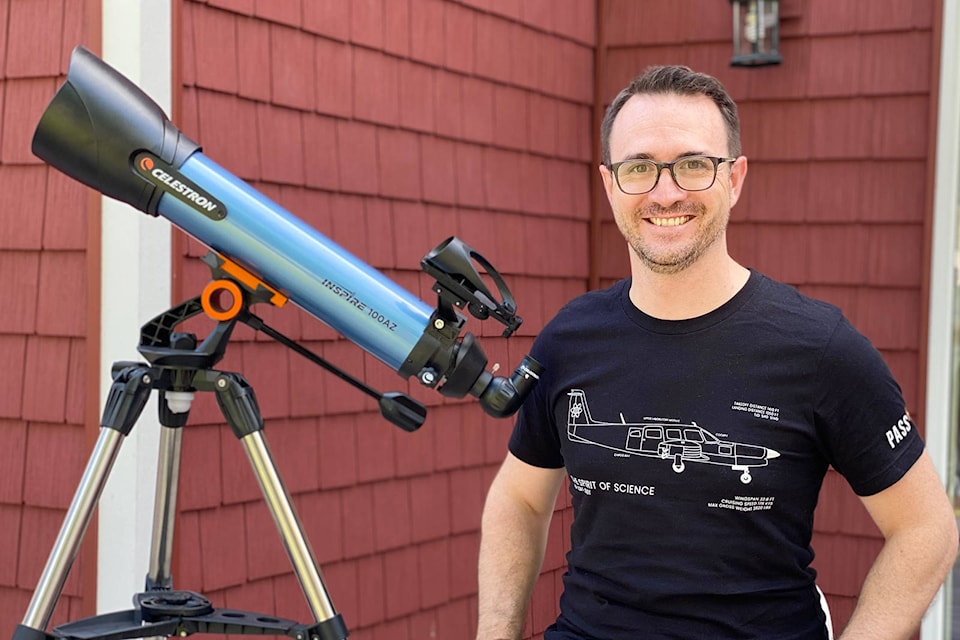A man whose purchase of a $13 telescope led him to eventually leave his career as an accountant and finance manager and become an astrophysicist will tell the Nanaimo Astronomy Society how to get the most out of their beginner telescopes.
John A. Read is a member of the Royal Astronomy Society of Canada and a telescope operator at the Burke-Gaffney Observatory in Halifax, N.S., will be the guest speaker at the Nanaimo Astronomy Society’s meeting this week.
Read started in astronomy in 2010 in Oakland, Calif., where he joined an amateur astronomy group. The years he spent learning about and teaching how to use telescopes taught him what budding astronomers most need to know to use their instruments effectively.
“I realized something and it’s that we spend a lot of time telling people what is the best beginner telescope or what they should get, but what we don’t do is spend time teaching them to use the telescope they probably already have or the one that they got for Christmas or on Amazon because it had great reviews,” Read said.
He estimates about half the telescopes that beginners own are not what astronomers would recommend for beginners. In his talk he’ll cover the various types of telescopes and mounts and how to set up and use them.
“The biggest hangup is getting set up and expecting to point it at the sky and see stuff immediately,” he said. “A telescope is a precision instrument. Things need to be aligned. Focus needs to be checked, you need to know what magnification you’re using and most people, if they don’t have an astronomy club to go to, they’ll skip that stuff.”
Most telescopes, for example, will come with a Barlow – a lens that acts as a magnifier – and users will install it because it came with the telescope.
“But what it does is it pushes the telescope beyond its maximum useful magnification and, so, when they go to look through it they’re not able to get things in focus. They’re not able to see Saturn’s rings or able to find stuff at all because their field of view is too small because they’re zoomed way too far in,” Read said.
Anyone can start enjoying astronomy with small, simple telescopes and there is always something in the night sky to view that falls within the capabilities of any instrument, something Read discovered with that first $13 telescope.
”I actually got into astronomy only 11 years ago,” Read said. “I was a late bloomer. I was only 27 or something and I actually fell in love with it and then after four years, I quit my job and got a degree in astrophysics.”
In the intervening years Read became a member of the Mount Diablo Astronomical Society in California and the Carolina Skygazers Astronomy Club in South Carolina. During his time volunteering with the Mount Diablo group he started teaching beginning astronomers and high school students how to use telescopes, including Dobsonian mount telescopes, which are easy to set up and learn with.
“I got very good at using amateur instruments and teaching other people how to use them,” Read said. “A lot of times I would teach students how to use the telescope and then just talk about space while they operated telescopes for me. I always used a 12-inch Dobsonian. You can teach anyone to use a 12-inch Dobsonian. I’d teach them how to find three or four things and then that student becomes a teacher fairly quick.”
The knowledge he gained from those experiences he applied to writing his first book 50 Things to See with a Small Telescope. Thousands of copies of the book have since sold and Read has also created his own publishing company.
This month’s Nanaimo Astronomy Society virtual meeting happens online Thursday, June 24. Read will be speaking from his home in Halifax so the meeting has an early 6 p.m. start time.
To learn more, visit www.nanaimoastronomy.com.
photos@nanaimobulletin.com
Like us on Facebook and follow us on Twitter
